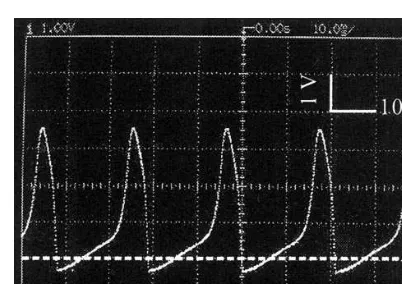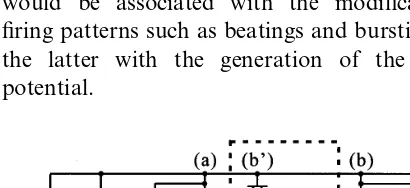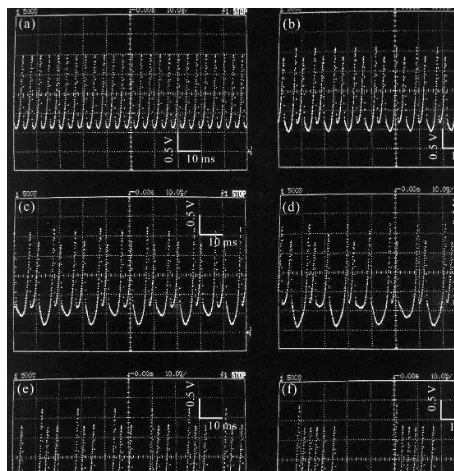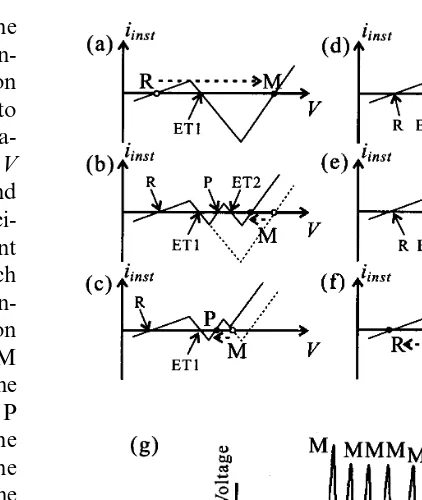A pulse-type hardware neuron model with beating, bursting
excitation and plateau potential
Yoshinobu Maeda
a,*, Hideo Makino
baDepartment of Biocybernetics,Faculty of Engineering,Niigata Uni
6ersity,8050Ikarashi-2,Niigata950-2181,Japan bDepartment of Information Engineering,Faculty of Engineering,Niigata Uni
6ersity,8050Ikarashi-2,Niigata950-2181,Japan
Abstract
We proposed a pulse-type hardware neuron model. It could reproduce simple excitations, beating and bursting discharges as well as an action potential with a plateau potential observed in living membranes. The model exhibited one of these dynamics depending on parameter values of the model’s circuit. They include resistance, capacitance and externally injected DC current intensity. We studied the model’s dynamics based on hardware experiments and mathematical analyses. Our results showed that two inward currents introduced into the model and differences in their operating time scales determined dynamics of the model. In particular, we illustrated a mechanism of the bursting discharges generation in terms of bifurcation theory and time-dependent changes in the form of instanta-neous current – voltage characteristics of the model. © 2000 Elsevier Science Ireland Ltd. All rights reserved.
Keywords:Bifurcation; Hodgkin – Huxley equation; Excitable media; Current – voltage relationship
www.elsevier.com/locate/biosystems
1. Introduction
Neuronal membranes generate brief electrical pulses, referred to as action potentials, spikes and firings as well. They are considered as the domi-nant information carrier in nervous systems. A typical excitable membrane generates an action potential in response to a brief electrical stimula-tion. It can also exhibit a regular train of action potentials (referred to as beating in this paper) in response to large enough DC current stimulation. A number of mathematical models of electrical excitations in living membranes have been
pro-posed after Hodgkin – Huxley (HH) equation (Hodgkin and Huxley 1952). They include HH-type, i.e. channel-based, equations. The HH-type equations for bursting excitations can reproduce alternating dynamics between active state accom-panied by several spikes and quiescent state with-out them (Rinzel and Lee 1986; Chay and Cook 1988; Hayashi and Ishizuka 1992; Rush and Rinzel 1994; Fan and Chay 1994; Guckenheimer et al. 1997). Some HH-type equations can gener-ate an action potential with a plgener-ateau potential common in cardiac Purkinje fiber cell (Noble 1966). Most of these models were constructed only by introducing extra-ionic channels (cur-rents) and by adding corresponding terms to the original HH equation. Successful reproductions of
* Corresponding author. Tel.: +81-25-2627776. E-mail address:[email protected] (Y. Maeda).
these diverse types of action potential generation by HH-type equations may be due to simple and
physiologically plausible formulation of the
equations.
Recently, modeling of membrane dynamics has begun to attract researches in the field of nonlin-ear dynamical system theory. For instance, sys-tematic changes in an appropriate physiological parameter value, such as externally injected cur-rent intensity, results in qualitative and abrupt changes in the living membrane dynamics. Such changes may be described by the bifurcation the-ory. Indeed, plausibility of recent proposed HH-type membrane models is evaluated not only by reproducibility of action potential waveforms at single fixed physiological parameter value but also by that at various parameter values (Chay and Cook 1988; Hayashi and Ishizuka 1992; Rush and Rinzel 1994; Fan and Chay 1994). In other words, a membrane model should be embedded appro-priately in the model’s parameter space so that it can reproduce a sequence of bifurcations exhib-ited by the real neuronal membrane as a function of physiological parameter values.
Our main interest of the present study is to construct a pulse-type hardware neuron (HN) model that can reproduce bursting discharges of action potentials emerging through a sequence of bifurcations. We use the term ‘pulse-type’ to dis-tinguish the models from conventional threshold devices as artificial neuron-like elements. Why ‘hardware’ models? There are several advantages to study HN models instead of purely mathemati-cal equations. (1) A HN model can provide real time processing. Thus it may be suited for study-ing a large-scale neural network dynamics when many HN models are connected with each other; (2) Physical interpretation of each parameter of a model is quite obvious, and, in some cases, it is easily associated with electro-physiological quan-tities of membranes; (3) Circuit dynamics can be described by a mathematical equation. Thus, one can achieve both circuit experiments and mathe-matical analyses for better understanding of the dynamics. Several pulse-type bursting HN models have been constructed under motivations similar to ours (Gulrajani et al. 1977; Sekine et al. 1999). To our knowledge, however, pulse-type HN
mod-Fig. 1. A model of an excitable membrane. The branches (a) and (b) correspond to the sodium and potassium ionic chan-nels, respectively.
els that can reproduce bursting discharges
emerg-ing through an appropriate sequence of
bifurcations (i.e. observed in physiological experi-ments) have not been reported.
2. Pulse-type hardware neuron model
Many pulse-type HN models of excitable mem-branes have been constructed (Harmon 1961; Mu-rai et al. 1977; Gulrajani et al. 1977; Hoshimiya et al. 1979; Keener 1983; Sekine et al. 1999). Fig. 1 illustrates the model proposed by Hoshimiya et al. It has four branches as in the electrical equivalent circuit of HH equation. V, C, RL, EL and Iext represent the membrane potential, membrane ca-pacitance, leakage resistance, leakage Nernst equi-librium potential and the injected DC current input, respectively. The branches (a) and (b)
cor-respond to the V-dependent inward sodium and
the delayed outward potassium ionic channels of HH equation, respectively. They are detailed in Fig. 2. Each of them consists of two units, that is, the ionic current part and the parallel-connected conductance-control part. The latter is marked by
the dotted square. ENa and EK correspond to
Fig. 3. Typical dynamics in the hardware neuron model of Fig. 1. The parameters areC=0.5mF,Cn=1.0mF,RL=100 kV, R1=200 kV,R2=2 kV,R3=100 kV,ENa=5 V,EK= −0.4 V, EL=0 V, T1=T3: npn-type 2SC1815, T2: pnp-type
2SA1015, andIext=0.1 mA. The ordinate is the membrane potentialV.
C; (vi) Vnshifts upward until it exceeds the cut-in voltage ofT3; (vii)T3is turned on; (viii)Vrapidly
shifts downward by IK from Collectorto Emitter
of T3. As the result, V varies suddenly down
toward EK.
When periodic pulse trains are applied to this model, the HN model shows either phase-locked or chaotic responses (Yamawaki et al., 1995). The firing frequency of the phase-locked response takes the form of an extended Cantor function. The chaotic response appears between the phase-locked responses. As such, it can show qualita-tively the same responses as those observed in the squid giant axon (Takahashi et al., 1990) and the FitzHugh – Nagumo (FHN) equation (Sato and Doi, 1992).
In the next section, we construct a bursting HN model by modifying this HN model. It can even show plateau potentials. We setR2=0 andEK=
EL=0 throughout the paper for simplicity.
3. Bursting hardware neuron model
Differential equation models of bursting dis-charges can be classified into several types such as
square-wave, parabolic and elliptic bursters
(Rinzel and Lee 1986; Bertram et al. 1995;
Guck-enheimer et al. 1997; Hoppensteadt and
Izhikevich 1997; De Vries and Miura 1998). The square-wave bursters show firings on plateau po-tentials, and they should be described by at least three variables (Chay and Cook 1988; Fan and Chay 1994; Av-Ron 1995; Maeda et al. 1998). One of the three variables is associated with an excitation with fast dynamics (fast variable or fast system) responsible for the depolarization of the plateau and action potentials. The second is a refractoriness of the fast variable (refractory fast system) responsible for the repolarization of the action potentials during each active state. The other is a refractory slow variable (slow system) responsible for the repolarization of the plateau potential, and its activation terminates the active state.
We propose a bursting HN model as shown in Fig. 4. The model’s dynamics can be described by three-dimensional differential equations. In com-sodium and potassium Nernst equilibrium
poten-tials in HH, respectively. A cut-in voltage of the transistorT1 acts as the excitation threshold. The sodium ionic currentINa is switched on when the
membrane potential V exceeds it. The potassium
ionic current IK is switched on when Vn in the
figure exceeds the cut-in voltage of the transistor
T3. In this HN model, the gating variablesmand
h of HH equation are not considered. Therefore,
the dynamics of the HN model can be described
by differential equations with two variables, V
and Vn. Thus, the HN model is regarded as a
reduced version of HH equation (FitzHugh 1961; Nagumo et al. 1962; Rinzel 1985; Kepler et al. 1992).
When the values of the resistors, the capacitors and the voltage sources are set so that the resting potential is equal to the potassium Nernst
equi-librium potential EK(50), this HN model shows
periodic beating discharges for an appropriate DC current injection (Fig. 3). The mechanisms of action potential generation in this model are briefly described as follows: (i) Iext charges up C untilVexceeds the cut-in voltage of T1; (ii)T1 is turned on; (iii) T2 is also turned on; (iv)INa that released from the source of ENa to the inside of
the membrane charges upC, and as the result, V
becomes more positive toward ENa(action
parison this bursting HN model with the simple excitable HN model shown in Fig. 1, the most important difference is that the former has two branches (b) and (b’) associated with active out-ward currents, while the latter has only one branch (b). The branch (b) of the bursting HN model corresponds to the refractory slow system. The branch (b’) represents the refractory fast sys-tem. It is a modification of (b) in Fig. 4, i.e. a transistor T4 is added.T4 completely rectifies the outward current of the branch (b’), since both
Base-EmitterandBase-Collectorunits are located in reverse directions against the inward current.
Therefore, the capacitor Cn cannot discharge
throughT4. So, whenT3is turned off,Vnremains constant, leading to the plateau potential. As the result, the excitable and the refractory fast sys-tems are able to regenerate the action potentials until the refractory slow system repolarizes the plateau potential. We obtained a typical bursting by choosing the capacitor and resistor values as follows: C=1/3, Cn=0.5, Cs=1.0 in mF, and
RL=100, R1=200, Rs=100 in kV, and ENa=5 in V.
In our circuit experiment, we changed the two parametersIext andRn systematically as the
bifur-cation parameters. First, we investigated influ-ences of Iext on behavior with Rn fixed to Rs/10, and then those ofRnfor a fixed Iext. We expected,
from the roles of each parameter, that the former would be associated with the modification of firing patterns such as beatings and burstings, and the latter with the generation of the plateau potential.
4. Results
4.1. Iext-dependent dynamics
For Iext\2.15 mA, V was at the quiescent
state. As the value of Iext decreased, beatings, periodic and chaotic burstings were observed in
this order. For IextB0.002 mA, V was at the
quiescent state again. Fig. 5 (a to f) shows the temporal waveforms ofVin their stationary states as typical dynamics of the bursting HN model. Those include, (a) beating; (b) periodic bursting with two spikes in one active state; (c) periodic bursting with two different active states with two spikes within each; (d) chaotic bursting; (e) peri-odic bursting with three spikes in one active state; and finally (f) periodic bursting with six spikes in one active state. The changes from (a) to (d), i.e. from the beating to the periodic bursting with three spikes, formed a cascade of the period-dou-bling bifurcations. We refer to the increase in the number of spikes during one active state from (d) to (f) as a ‘period-adding’.
4.2. Rn-dependent dynamics
We summarize theRn-dependent changes in the
dynamics of the model. Here,Iextwas fixed at 0.01
mA. As Rn decreased, amplitudes of the action
potentials during the active states became smaller. A typical behavior is exemplified in Fig. 6(a) (Rn=8 kV). As Rn decreased further, only one
action potential was observed at the beginning of each active state. Fig. 6(b) (Rn=5 kV) shows this
behavior. The temporal waveform with the plateau potential was similar to that observed in the cardiac Purkinje fibers.
4.3. Generating mechanism of bursting discharge
In order to clarify the mechanism of bursting generations, we investigated instantaneous cur-rent-voltage relationsiinst=iinst(V) of the bursting HN model. Fig. 7(a – f) illustrates time-dependent changes in the shape of iinst-Vcurve at appropri-ate instants during the bursting. For some in-stants, there were two negative resistance regions (for example, Fig. 7(b) and (d)) and five roots on
Fig. 5. Typical dynamics of the bursting hardware neuron model. The parameters are Rn=10 kV,T1=T3=T4=T5: npn-type
2SC1815,T2: pnp-type 2SA1015.Iextis set to (a) 0.7, (b) 0.6, (c) 0.45, (d) 0.30, (e) 0.2 (f) 0.01 in mA, respectively. The ordinates are the membrane potentialV.
the horizontal axis (iinst(V)=0), as indicated by the symbols R, ET1, P, ET2, and M. These voltages were associated with the resting poten-tial, the excitation threshold for plateau potential
onset, the plateau potential, the excitation
threshold for the action potential onset and the
maximum value of the action potential,
When the state point was at the point R, the DC current input brought the membrane poten-tial (the state point) toward the excitation threshold ET1. Then the state point started to move to the point M (Fig. 7(a)). The depolariza-tion of the membrane potential shifted the iinst-V
curve between ET1 and M upward, and P and ET2 appeared (Fig. 7(b)). This change was associ-ated with increases of the delayed outward current generated by the refractory fast system (branch (b’) in the circuit). As the outward current in-creased, the right side negative resistance portion was shifted upward. It caused that the point M collided with ET2, and they vanished. Then the state point rapidly moved back to the point P (Fig. 7(c)). This repolarization of the membrane potential induced the downward shift of the curve, since the inward current generated by the
Fig. 7. Mechanism of bursting discharge generations. (a) – (f) Schematic diagrams of the time-dependent changes in the instantaneous current – voltage curve of the bursting HN model. Three stable points R, P and M correspond to the resting, the plateau and the maximum peak potential, respec-tively. Two unstable points ET1 and ET2 are excitation thresholds, respectively. Abscissas are the voltage and ordi-nates are the outward current. (g) Qualitative corresponding points ofR,PandMto the temporal waveform
Fig. 6. Stationary temporal waveforms with the plateau poten-tials. The parameters are Iext=0.01 mA, T1=T3=T4=T5:
npn-type 2SC1815.Rnis set to (a) 8 kV, (b) 5 kV.
excitable fast system (branch (a) in the circuit) increased again. Then ET2 and M appeared again (Fig. 7(d)), before P collides with ET2. The state point rapidly moved to the point M again (Fig. 7(e)), after P and ET2 vanished. This process from Fig. 7(b) to (e) repeated several times de-pending on the number of the spikes within one active state. During the active state, the refractory slow system (branch (b) in the circuit) was acti-vated gradually. The outward current generated by the refractory slow system caused the upward shift of the curve betweenRandP. Eventually the point P collides with ET1, and they vanished. As the result, the state point moved back to the point
5. Discussion
We constructed a bursting hardware neuron (HN) model, and analyzed its dynamics and bifur-cations. We obtained a sequence of bifurcations in the model. These were the period-doubling from beating to bursting and the period adding cascade
as Iext changed. Such similar bifurcations have
been observed in the physiological experiment in bursting cells. They have been also observed in
many pulse-type mathematical models (e.g.
Hayashi and Ishizuka 1992; Fan and Chay 1994). Thus, one can consider that these are universal features of bursting neurons and their models. As
Rn changed, the HN model showed the action
potentials with the plateau potential.
We show that each of the five branches of our two-terminal electronic circuit model can be inter-preted physiologically based on the corresponding ionic channels. Although we did not describe the result in this short paper, we confirmed that the temporal waveform of the equivalent potentialVs was similar to those of the slow dynamics of the intracellular calcium concentration of the pancre-atic b-cell model with two outward currents (the
delayed and the Ca-dependent potassium ionic
channels) (Fan and Chay 1994; Av-Ron 1995). In this sense, the branches (b’) and (b) of Fig. 4 can be interpreted as the delayedV-dependent and the
Ca-dependent potassium ionic channels,
respec-tively. The original HH equations can also show the plateau potentials when the dynamics of the potassium activation variablen is set slower than
the sodium inactivation variable h (Doi and
Ku-magai 1999). In this sense, the branch (b’) of Fig. 4 could be also reinterpreted as the inactivation system of the sodium ionic channel, though we regarded it as the delayed potassium ionic chan-nel. It is possible to accept these two interpreta-tions based on the fact that the activation of the potassium ionic channel and the inactivation of the sodium ionic channel synergistically cause the outward current.
We showed that our HN model could repro-duce relatively rich nonlinear dynamics ranging from beating to bursting dynamics. Nevertheless, our model consisted of just five transistors, four resistors, three capacitors and one voltage source,
so that it could be treated as a minimal bursting hardware neuron model. One can easily imple-ment our model into an analog circuit, and utilize it as one of the components of realistic artificial neural networks. It is our future subject to con-struct a network of our HN models and to inves-tigate how its dynamics changes as a function of dynamics of each HN model.
Acknowledgements
The authors would like to thank Professor Shunsuke Sato and Professor Donald Nicholson Parkes for their helpful discussions. YM thanks Professor Oscar Diez Martinez for reading our manuscript and for valuable comments.
References
Av-Ron, E., 1995. Modeling a small neural network: the lobster cardiac ganglion. J. Biol. Sys. 3, 4, 1087 – 1104. Bertram, R., Butte, M.J., Kiemel, T., Sherman, A., 1995.
Topological and phenomenological classification of burst-ing oscillations. Bull. Math. Biol. 57, 413 – 439.
Chay, T.R., Cook, D.L., 1988. Endogenous bursting patterns in excitable cells. Math. Biosci. 90, 139 – 153.
De Vries, G., Miura, R.M., 1998. Analysis of a class of models of bursting electrical activity in pancreaticb-cells. SIAM J. Appl. Math. 58, 607 – 635.
Doi, S., Kumagai, S., 1999. Rich nonlinear dynamics of HH-type neurons with multiple time scales. The 3rd Int. Workshop on Neuronal Coding, 117 – 120.
Fan, Y.S., Chay, T.R., 1994. Generation of periodic and chaotic bursting in an excitable cell model. Biol. Cybern. 71, 417 – 431.
FitzHugh, R., 1961. Impulses and physiological states in theo-retical models of nerve membrane. Biophys. J. 1, 445 – 466. Guckenheimer, J., Harris-Warrick, B., Peck, J., Willms, A., 1997. Bifurcation, bursting, and spike frequency adapta-tion. J. Comp. Neurosci. 4, 257 – 277.
Gulrajani, R.M., Roberge, F.A., Mathieu, P.A., 1977. The modelling of a burst-generating neuron with a field-effect transistor analog. Biol. Cybern. 25, 227 – 240.
Harmon, L.D., 1961. Studies with artificial neurons, I: Proper-ties and functions of an artificial neuron. Kybernetik 1, 89 – 101.
Hayashi, H., Ishizuka, S., 1992. Chaotic nature of bursting discharge in theOnchidium pacemaker neuron. J. Theor. Biol. 156, 269 – 291.
Hoppensteadt, F.C., Izhikevich, E.M., 1997. Weakly Con-nected Neural Networks. Springer.
Hoshimiya, N., Yoshida, S., Shogen, K., Matsuo, T., 1979. Two-terminal electronic circuit neuron model with ex-citable membrane V-I-t characteristics. Biol. Cybern. 35, 125 – 130.
Keener, J.P., 1983. Analog circuitry for the van der Pol and FitzHugh-Nagumo equations. IEEE Trans., SMC-13 5, 1010 – 1014.
Kepler, T.B., Abbott, L.F., Marder, E., 1992. Reduction of conductance-based neuron models. Biol. Cybern. 66, 381 – 387.
Maeda, Y., Pakdaman, K., Nomura, T., Doi, S., Sato, S., 1998. Reduction of a model for anOnchidiumpacemaker neuron. Biol. Cybern. 78, 265 – 276.
Murai, T., Yagi, H., Yotuya, H., 1977. Electronical excitable membrane model with time variant negative resistance. Technical Report of IEICE, MBE77-6, 19 – 24 (in Japanese).
Nagumo, J., Arimoto, J., Yoshizawa, S., 1962. An active pulse transmission line stimulating nerve axon. Proc IRE 50, 2061 – 2070.
Noble, D., 1966. Applications of Hodgkin-Huxley equations to excitable tissue. Phys. Rev. 46 (1), 1 – 50.
Rinzel, J., 1985. Excitation dynamics: insights from simplified membrane models. Fed. Proc. 44, 2944 – 2946.
Rinzel, J., Lee, Y.S., 1986. On different mechanisms for mem-brane potential bursting. In: Othmer, H.G. (Ed.), Lecture Notes in Biomathematics. Springer, pp. 19 – 33.
Rush, M.E., Rinzel, J., 1994. Analysis of bursting in a thala-mic neuron model. Biol. Cybern. 71, 281 – 291.
Sato, S., Doi, S., 1992. Response characteristics of the BVP neuron model to periodic stimuli. Math. Biosci. 112, 243 – 259.
Sekine, Y., Someya, K., Saeki, K., Aihara, K., 1999. A study on neuronal coding using pulse-type hardware chaotic neuron model. The 3rd Int. Workshop on Neuronal Cod-ing, 121 – 124.
Takahashi, N., Hanyu, Y., Musha, T., Kubo, R., Matsumoto, G., 1990. Global bifurcation structure in periodically stim-ulated giant axons of squid. Physica D 43, 318 – 334. Yamawaki, N., Sato, S., Doi, S., 1995, Effect of the stimulus
pulse width upon the stimuli-response characteristics of an electronic excitable membrane model. Trans, IEE of Japan, 115-C, 1541-1547 (in Japanese).




